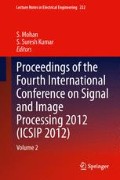Abstract
In Multiple Input Multiple Output (MIMO) system, both transmitter and receiver are provided with more than one antenna to increase the channel capacity and quality. This paper describes the simulated results of microstrip balun fed two and four element printed dipole array antenna using ADS software for wireless communication applications and revealed that the return loss of 4 element side by side array antenna is −24.04 dB at 5.6 GHz. When the spacing between the elements is less than 0.5λ, the effect of mutual coupling is more. The mutual impedance between antenna elements is computed from the measured S parameters and it is below 24 dB for the measured frequency range 4–6.8 GHz. The designed antennas are characterized by measuring return loss, directivity, radiation pattern and gain. Gain and directivity of four element array is 8.85 dBi and it radiates 18.9 mW power. The performance of arrays is evaluated using capacity as the metric based on Monte Carlo realizations of the channel with inclusive of mutual coupling between dipoles.
Access this chapter
Tax calculation will be finalised at checkout
Purchases are for personal use only
References
Foschini BGJ, Gans MJ (1998) On limits of wireless communications in a fading environment when using multiple antennas. Wireless Personal Comm 6: 311–335 (Mar)
Waldschmidt C, Fugen T, Wiesbeck W (2002) Spiral and dipole antennas for indoor MIMO-systems. IEEE Antennas Wireless Propagat Lett 1(1):176–178
Martin CC, Winters JH, Sollenberger NR (2001) MIMO radio channel measurements: performance comparison of antenna configurations. In Proceeding IEEE 54th Veh. Technol. Conf., vol.2, Atlantic City, NJ, Oct. 7–11, (2001), 1225–1229
Li X, Yang L, Gong S-X, Yang Y-J (2009) Dual-band and wideband design of a printed dipole antenna integrated with dual band balun. Prog Electromagnet Res Lett 6:165–174
Svantesson T, Ranheim A (2001) Mutual coupling effects on the capacity of multielement antenna systems. In: Proceeding IEEE international conference acoustics, speech, and signal processing, vol 4, Salt Lake City, 7–11 May, pp 2485–2488
Michailidis E, Tsimenidis C, Chester G (2007) Printed dipole array for MIMO wireless networks. In: Proceeding IEEE Loughborough antennas and propagation conference, April 2007, pp 117–120
Edward B, Rees D (1987) A broadband printed dipole with integrated balun. Microwave J, May, pp 339–344
Chuang H-R, Kuo L-C (2003) 3-D FDTD design analysis of a 2.4 GHz polarization-diversity printed dipole antenna with integrated balun and polarization-switching circuit for WLAN and wireless communication applications. IEEE Trans Microwave Theor Tech 51(2): 374–381
Bayard J-PR (1994) Analysis of infinite arrays of microstrip-fed dipoles printed on protruding dielectric substrates and covered with a dielectric radome. IEEE Trans Antennas Propag 42(1): 82–89
Shuangqing W, Goeckel DL, Janaswamy R (2003) On the asymptotic capacity of MIMO systems with fixed length linear antenna arrays. In: IEEE International Conference on communications, vol 4, Amherst, MA, 11–14 May 2003, pp 2633–2637
Svantesson T (2001) A physical MIMO radio channel model for multi-element multi-polarized antenna systems. In: Proceedings IEEE 54th vehicular technology conference, vol 2, Atlantic City, NJ, 7–11 Oct 2001, pp 1083–1087
Advanced Design System (ADS) (2011) Agilent Technologies, USA
Author information
Authors and Affiliations
Corresponding author
Editor information
Editors and Affiliations
Rights and permissions
Copyright information
© 2013 Springer India
About this paper
Cite this paper
Poongodi, C., Shanmugam, A., Prabhu, P. (2013). Design of Two Element and Four Element Printed Dipole Array Antennas for Wireless Communication Applications. In: S, M., Kumar, S. (eds) Proceedings of the Fourth International Conference on Signal and Image Processing 2012 (ICSIP 2012). Lecture Notes in Electrical Engineering, vol 222. Springer, India. https://doi.org/10.1007/978-81-322-1000-9_23
Download citation
DOI: https://doi.org/10.1007/978-81-322-1000-9_23
Published:
Publisher Name: Springer, India
Print ISBN: 978-81-322-0999-7
Online ISBN: 978-81-322-1000-9
eBook Packages: EngineeringEngineering (R0)

